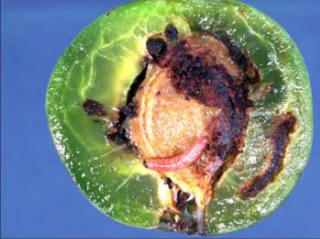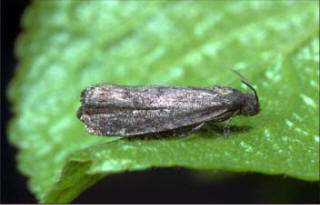The Plum Moth is starting to be a big pest for gardeners in the UK. It has always been a pest in many US states and also throughout Europe, but it is only recently emerging as a serious pest in the UK. It is a known pest in Asian countries, so may well be an import into the country, where the (generally) milder climates are developing – allowing the Plum Moth – and other insect pests to live.
As the name suggests, the Plum Fruit Moth causes damage to plums, damsons and greengages. It has also been found in Apricots on the US, so presumably home grown Peaches might also be a target in the UK. In keeping with most fruit pests, it is mainly troublesome in the fruit itself – rarely damaging the foliage or flowers.
The damage is caused by the larva – maggot – of the Plum Moth, and this comes about by the adult moth laying its eggs on the fruit’s underside during the summer months – before the fruit matures. The eggs hatch out to minute maggots which then find their way into the developing fruit and happily chomp away – relatively unnoticed until the fruit matures, for it is within the fruit for its part of the life cycle of the Plum Moth. The main source of attach is inside the fruit – adjacent to the ‘stone’ or seed.
 Early
ripening and coloration of the fruit is one of the external
identifications. By this time of course, it is too late to do anything
about it – other than destroy the fruit! More often than not, it is not
noticed until cutting open the fruit – hopefully not eating it – when
the pink or light red larva will be found!
Early
ripening and coloration of the fruit is one of the external
identifications. By this time of course, it is too late to do anything
about it – other than destroy the fruit! More often than not, it is not
noticed until cutting open the fruit – hopefully not eating it – when
the pink or light red larva will be found!
Presumably the caterpillar, grub or maggot, drops with the ripened fruit, for it then carries on the life cycle by way of pupating in debris, soil or under tree bark. It is not unknown for three generations in a year – though at most two are though for the UK.
 The
adult moth is just a cm long with a short wingspan of around 15mm max.
So it is not the most visible of moths. The rear wings are brown, but
with black mottled markings.
The
adult moth is just a cm long with a short wingspan of around 15mm max.
So it is not the most visible of moths. The rear wings are brown, but
with black mottled markings.
The grub itself is pink or light red, whilst the pupa is light brown, and found in a slightly crusty cocoon.
Close inspection of fruit may reveal flat white eggs – minute – upon the underside of the fruit or on the fruit stalk itself.
Early ripened fruit may possibly reveal the active maggot if cut open. It will be adjacent to the fruit stone. Early fruit drop of Plums, Damsons and Gages might be an indication. It is also possible to find the small tunnel into the fruit upon close inspection. This will often be identified by an oozing gummy mixture.
Pheromone Traps will work in trapping the male population – without which of course there will e no eggs. Insecticides are not the answer for timing has to be perfect, and continual spraying would be necessary. Undesirable and not practicable!
Cleanliness around at the base of the tree is one of the best control methods, for the young moths emerge at several times from early to late summer.
Main Page for Apple Tree Problems